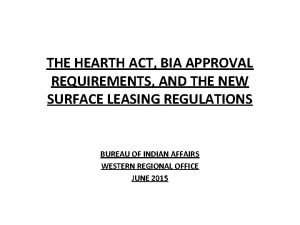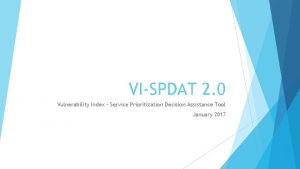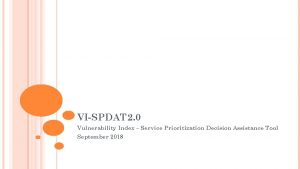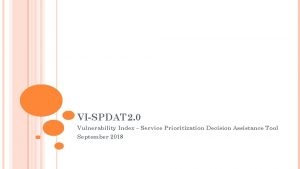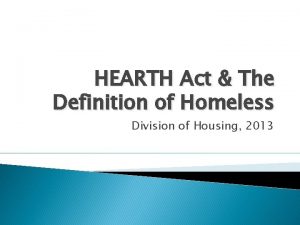Introducing the VISPDAT WHY The HEARTH Act and










- Slides: 10

Introducing the VI-SPDAT

WHY? • The HEARTH Act and federal regulations require communities to develop a mechanism for common assessment and coordinated access • Communities need a practical, evidence-informed way to satisfy federal regulations while quickly implementing an effective approach to access and assessment. • The Vulnerability Index-Service Prioritization and Decision Assistance Tool (VI-SPDAT) is a first-of-its-kind tool designed to fill this need, helping communities end homelessness in a quick, strategic fashion.

Recommended by our Co. C Planning Group • Used by two agencies for the last year • Recommended use of VI-SPDAT for all agencies who participate in our Coordinated Assessment System

About the VI-SPDAT • The VI-SPDAT is a “supertool” that combines the strengths of two widely used existing assessments: • The Vulnerability Index (VI), developed by Community Solutions, is a street outreach tool currently in use in more than 100 communities. Rooted in leading medical research, the VI helps determine the chronicity and medical vulnerability of homeless individuals. • The Service Prioritization Decision Assistance Tool (SPDAT), developed by Org. Code Consulting, is an intake and case management tool in use in more than 70 communities. Based on a wide body of social science research and extensive field testing, the tool helps service providers allocate resources in a logical, targeted way.

• The tool helps identify the best type of support and housing intervention for an individual by relying on three categories of recommendation: • Permanent Supportive Housing: Individuals or families who need permanent housing with ongoing access to services and case management to remain stably housed. • Rapid Re-Housing: Individuals or families with moderate health, mental health and/or behavioral health issues, but who are likely to be able to achieve housing stability over a short time period through a medium or short-term rent subsidy and access to support services. • Affordable Housing: Individuals or families who do not require intensive supports but may still benefit from access to affordable housing. In these cases, the tool recommends affordable or subsidized housing but no specific intervention drawn uniquely from the homeless services world. (In most cases, this amounts to saying simply, “no case management. ”)

• The VI-SPDAT helps identify who should be recommended for each housing and support intervention, moving the discussion from simply who is eligible for a service intervention to who is eligible and in greatest need of that intervention.

Why We Need the VI-SPDAT • The average community currently allocates housing resources on a first come-first served basis or “Cherry Picks” admissions. • Individuals and families take their place at the bottom of endless waiting lists, regardless of their chronicity, medical vulnerability, acuity, or ability to address their own housing instability. • The result is often akin to an emergency room devoting its costliest resources to a common cold patient while leaving a late-arriving heart attack victim to fend for him or herself.

Why we Need the VI-SPDAT (cont. ) • By contrast, the VI-SPDAT allows communities to assess clients’ various health and social needs quickly and then match them to the most appropriate-- rather than the most intensive-- housing interventions available.

Why we Need the VI-SPDAT (cont. ) • The VI-SPDAT takes the pressure off of service providers to make difficult, emotionally fraught decisions and reframes the moment of assistance as an opportunity to match each client with the best housing and service options for his or her individual needs. • In an environment of increasingly limited resources, it also helps communities avoid “subsidy overkill” by targeting their most intensive supports toward those who research shows will not make effective use of a lesser subsidy. Eg: RRH v PSH

HMIS and VI-SPDAT • Our HMIS system – Service. Point by Bowman Systems • Added VI-SPDAT as subassessment at end of December for all • Completing the subassessment will become a part of our coordinated assessment system
 Hey hey bye bye
Hey hey bye bye Hearth act
Hearth act Hearth act of 2012
Hearth act of 2012 Introducing and naming new products and brand extensions
Introducing and naming new products and brand extensions Introducing and naming new products and brand extensions
Introducing and naming new products and brand extensions Macbeth act 2 summary
Macbeth act 2 summary Dont ask
Dont ask The hearth and the salamander
The hearth and the salamander The gibbering pack of three apes
The gibbering pack of three apes Salamander fahrenheit 451
Salamander fahrenheit 451 A concise introduction to linguistics answer key
A concise introduction to linguistics answer key











